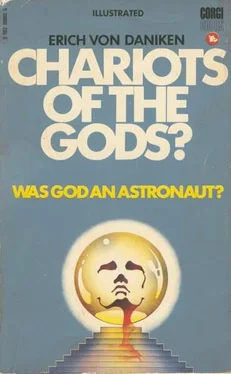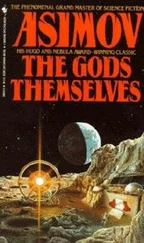Erich Daniken - Chariots of the Gods
Здесь есть возможность читать онлайн «Erich Daniken - Chariots of the Gods» весь текст электронной книги совершенно бесплатно (целиком полную версию без сокращений). В некоторых случаях можно слушать аудио, скачать через торрент в формате fb2 и присутствует краткое содержание. Жанр: Физика, на английском языке. Описание произведения, (предисловие) а так же отзывы посетителей доступны на портале библиотеки ЛибКат.
- Название:Chariots of the Gods
- Автор:
- Жанр:
- Год:неизвестен
- ISBN:нет данных
- Рейтинг книги:3 / 5. Голосов: 1
-
Избранное:Добавить в избранное
- Отзывы:
-
Ваша оценка:
- 60
- 1
- 2
- 3
- 4
- 5
Chariots of the Gods: краткое содержание, описание и аннотация
Предлагаем к чтению аннотацию, описание, краткое содержание или предисловие (зависит от того, что написал сам автор книги «Chariots of the Gods»). Если вы не нашли необходимую информацию о книге — напишите в комментариях, мы постараемся отыскать её.
Chariots of the Gods — читать онлайн бесплатно полную книгу (весь текст) целиком
Ниже представлен текст книги, разбитый по страницам. Система сохранения места последней прочитанной страницы, позволяет с удобством читать онлайн бесплатно книгу «Chariots of the Gods», без необходимости каждый раз заново искать на чём Вы остановились. Поставьте закладку, и сможете в любой момент перейти на страницу, на которой закончили чтение.
Интервал:
Закладка:
According to priestly tradition, the 'gods' would come back from heaven when the vast buildings were completed according to the laws of the calendar cycle. So the people hastened to complete temples and pyramids according to this holy rhythm, because the year of completion was supposed to be a year of rejoicing. Then the god Kukulkan would come from the stars, take possession of the buildings and from then on live among mankind.
The work was finished, the year of the god's return came round—but nothing happened. The people sang, prayed and waited for a whole year. Slaves and jewellery, corn and oil were offered up in vain. But heaven remained dumb and without a sign. No heavenly chariot appeared; they could hear no rushing or distant thunder. Nothing, absolutely nothing happened.
If we give this hypothesis a chance, the disappointment of priests and people must have been tremendous. The work of centuries had been done in vain. Doubts arose. Was there a mistake in the calculation of the calendar? Had the 'gods' landed somewhere else? Had they all made a terrible mistake?
I should mention that the mystical year of the Mayas, in which the calendar began, goes back to 311 B.C. Proofs of this exist in Mayan writings. If we accept this date as proved, then there was only a gap of a few hundred years between it and the beginning of the Egyptian culture. This legendary age seems to be genuine, because the hyper-accurate Mayan calendar says so over and over again. If this is so, the calendar and the national migration are not the only things that make me sceptical. For a comparatively new find starts off nagging doubts, too.
In 1935 a stone relief that very probably represents the god Kukumatz (in Yucatan, Kukulkan) was found in Palenque (Old Kingdom). A genuinely unprejudiced look at this picture would make even the most die-hard sceptic stop and think.
There sits a human being, with the upper part of his body bent forward like a racing motorcyclist; today any child would identify his vehicle as a rocket. It is pointed at the front, then changes to strangely grooved indentations like inlet ports, widens out and terminates at the tail in a darting flame. The crouching being himself is manipulating a number of undefinable controls and has the heel of his left foot on a kind of pedal. His clothing is appropriate: short trousers with a broad belt, a jacket with a modern Japanese opening at the neck and closely fitting bands at arms and legs. With our knowledge of similar pictures, we should be surprised if the complicated headgear were missing. And there it is with the usual indentations and tubes, and something like antennae on top. Our space traveller—he is clearly depicted as one—is not only bent forward tensely, he is also looking intently at an apparatus hanging in front of his face. The astronaut's front seat is separated by struts from the rear portion of the vehicle, in which symmetrically arranged boxes, circles, points and spirals can be seen.
What does this relief have to tell us? Nothing? Is everything that anyone links up with space travel a stupid figment of the imagination?
If the stone relief from Palenque is also rejected from the chain of proofs, one must doubt the integrity which scholars bring to the investigation of outstanding finds. After all, one is not seeing ghosts when one is analysing actual objects.
To continue with our series of hitherto unanswered questions: why did the Mayas build their oldest cities in the jungle, and not on a river, or by the sea? Tikal, for example, lies 109 miles as the crow flies from the Gulf of Honduras, 161 miles north-west of the Bay of Campeche and 236 miles as the crow flies north of the Pacific Ocean. The fact that the Mayas were quite familiar with the sea is shown by the wealth of objects which were made of coral, mussels and shellfish. Why, then, the 'flight' into the jungle? Why did they build water reservoirs when they could have settled by the water? In Tikal alone there are thirteen reservoirs with a capacity of 214,504 cubic yards. Why did they absolutely have to live, build and work here and not in some more 'logically' situated place?
After their long trek the disappointed Mayas founded a new kingdom in the north. And once again cities, temples and pyramids arose according to the dates pre-fixed by the calendar.
To give some idea of the accuracy of the Mayan calendar, here are the periods of time they used:
20 kins = 1 uinal or 20 days
18 uinals = 1 tun or 360 days
20 tuns = 1 katun or 7,200 days
20 katuns = 1 baktun or 144,000 days
20 baktuns = 1 pictun or 21,880,000 days
20 pictuns = 1 calabtun or 571,600,000 days
20 calabtuns = 1 kinchiltun or 12,1521,000,000 days
20 kinchiltuns = 1 atautun or 232,0401,000,000 days
But the stone steps based on calendar dates are not the only things that tower above the green roof of the jungle, for observatories were built, too.
The observatory at Chichen is the first and oldest round building of the Mayas. Even today the restored building looks like an observatory. The circular edifice rises far above the jungle on three terraces; inside it a spiral staircase leads to the uppermost observation post; in the dome there are hatches and openings directed at the stars and giving an impressive picture of the firmament at night. The outer walls bear masks of the rain god ... and the image of a human figure with wings.
Admittedly the Mayas' interest in astronomy is not sufficient motivation for our hypothesis of relations with intelligences on other planets. The abundance of hitherto unanswered questions is bewildering: how did the Mayas know about Uranus and Neptune? Why are the observation posts in the observatory at Chichen not directed at the brightest stars? What does the stone relief of the rocket-driving god at Palenque mean? What is the point of the Mayan calendar with its calculations for 400 million years! Where did they get the knowledge required to calculate the solar and Venusian years to four decimal places? Who transmitted their inconceivable astronomical knowledge? Is every fact a chance product of the Mayan intellect or does each fact, or rather do all the facts added together, conceal a revolutionary message for a very distant future, as seen from their point in time?
If we put all the facts in a sieve and roughly separate the wheat from the chaff, there are so many inconsistencies and absurdities left that research needs spurring on to make a large-scale new effort to solve at least some of the enormous number of problems. For in our age research should no longer remain satisfied when confronted with so-called 'impossibilities'.
I have one more, rather gruesome story to tell, the story of the Sacred Well of Chichen Itza. From the stinking mud of this well Edward Herbert Thompson excavated not only jewellery and objects of art, but also the skeletons of youths and maidens. Drawing on ancient accounts, Diego de Landa stated that in times of drought the priests used to make pilgrimages to the well to appease the wrath of the rain god by throwing boys and girls into it in the course of a solemn ceremony.
Thompson's finds proved de Landa's claim. A horrifying story, which also brings up more questions from the bottom of the well. How did this water-hole come into being? Why was it declared a sacred well? Why this well in particular, for there are several like it?
The exact counterpart of the sacred well of Chichen Itza exists, hidden in the jungle barely seventy-six yards from the Mayan observatory. Guarded by snakes, poisonous millipedes and troublesome insects, the hole has the same measurements as the 'real' well; its vertical walls are equally weathered, overgrown and swamped by the jungle. These two wells resemble each other most strikingly. The water is the same depth and the colour shimmers from green to brown and blood-red in both wells. Unquestionably the two wells are the same age and possibly they both owe their existence to the impact of meteorites. Meanwhile, contemporary scholars speak only of the sacred well of Chichen Itza; the second well, which is so similar, does not fit into their theories, although both wells are 984 yards away from the top of the biggest pyramid, the Castillo. This pyramid belongs to the god Kukulkan, the 'Feathered Serpent'.
Читать дальшеИнтервал:
Закладка:
Похожие книги на «Chariots of the Gods»
Представляем Вашему вниманию похожие книги на «Chariots of the Gods» списком для выбора. Мы отобрали схожую по названию и смыслу литературу в надежде предоставить читателям больше вариантов отыскать новые, интересные, ещё непрочитанные произведения.
Обсуждение, отзывы о книге «Chariots of the Gods» и просто собственные мнения читателей. Оставьте ваши комментарии, напишите, что Вы думаете о произведении, его смысле или главных героях. Укажите что конкретно понравилось, а что нет, и почему Вы так считаете.











